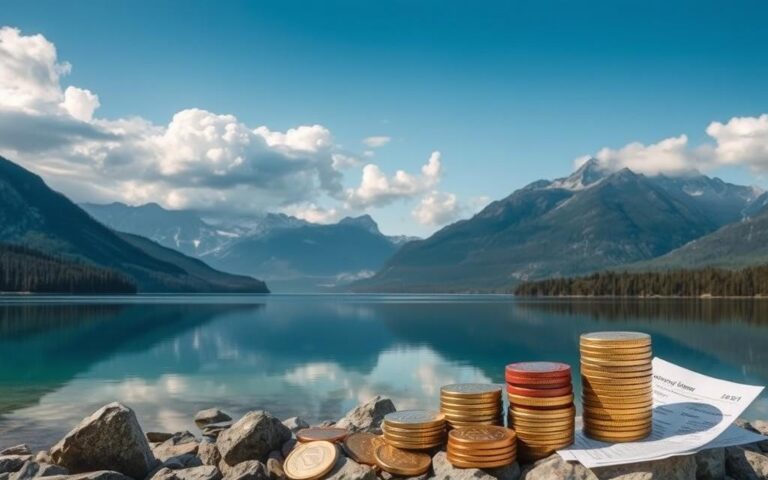adversiment
In 2022, Canadians borrowed over $2 trillion in loans. This includes personal finances and real estate. Navigating the Canadian lending landscape can be tricky. This guide will help you find the best loan for your needs.
Understanding different loan types is crucial. Interest rates and eligibility requirements are also important. We’ll explore various loan options available in Canada.
We’ll discuss key factors to consider when choosing a loan. You’ll learn how to assess your financial situation. We’ll also cover how to compare lenders effectively.
This guide will equip you with essential knowledge. You’ll be able to make an informed decision. You’ll be ready to secure the best loan for your needs.
Understanding the Types of Loans Available in Canada
Canada offers various loan options to finance your goals. These include personal loans, home equity loans, auto loans, and student loans. Each type has unique features for different needs.
Personal Loans
Personal loans in Canada are flexible financing solutions. They can fund debt consolidation, home renovations, or special events. These loans often have fixed rates and terms, providing predictable monthly payments.
Home Equity Loans
Home equity loans let homeowners tap into their property’s value. They can fund large expenses like home improvements or investments. These loans usually offer lower interest rates than other types.
However, they use your home as collateral. This adds a risk factor to consider before borrowing.
Auto Loans
Auto loans are specifically for buying new or used vehicles. They typically have fixed rates and terms matching the vehicle’s expected lifespan. These loans make car purchases more manageable by spreading costs over time.

Student Loans
Student loans help fund post-secondary education in Canada. They cover tuition, textbooks, and other school expenses. Student loans often have lower rates and flexible repayment options.
Exploring these loan types helps you choose the best option. Consider your goals and budget when making a decision.
Factors to Consider When Choosing a Loan
Selecting a loan in Canada requires careful thought. The loan amount, interest rates, and loan terms are crucial factors. These elements help you find the best loan option for your needs.
Loan Amount
Determine the right loan amount based on your financial needs. Consider the loan’s purpose and your ability to make monthly payments. Borrow only what you can comfortably afford to avoid financial strain.
Interest Rates
Interest rates greatly affect the overall cost of borrowing. Learn about current rates in Canada, as they vary by lender and loan type. Your creditworthiness also impacts the rate you’ll receive.
Understanding how interest rates work helps you make an informed decision. It allows you to better estimate your monthly payments and total loan cost.
Loan Terms
Loan terms include the repayment period and payment frequency. Longer terms may lower monthly payments but increase overall interest costs. Evaluate the terms carefully to ensure they fit your financial goals and budget.
“Taking the time to thoroughly understand the factors involved in choosing a loan can help you make the best decision for your financial well-being.”
By weighing these key factors, you can make a smart choice. This approach helps you find the loan option that best fits your needs and financial situation.
How to Evaluate Your Financial Situation
Assessing your financial health is vital before exploring Canadian loan guide options. This evaluation helps determine your borrowing capacity. It also identifies factors affecting your loan eligibility.
Key factors to consider are income and expenses, credit score, and debt-to-income ratio. Let’s examine each of these elements closely.
Income and Expenses
Start by examining your monthly income and expenses. Add up your regular income sources, including employment and investments. Then, review your essential and discretionary spending.
This exercise reveals your financial obligations and cash flow. It shows your ability to manage loan repayments comfortably.
Credit Score Importance
Your credit score is crucial for lenders evaluating your loan application. This number reflects your creditworthiness and payment history. A healthy credit score can improve your chances of securing favorable loan terms.
Debt-to-Income Ratio
The debt-to-income ratio (DTI) compares monthly debt payments to gross monthly income. Lenders use DTI to assess your ability to manage additional debt. Keeping your DTI below 40% enhances your chances of loan approval.
| Metric | Importance | Ideal Range |
|---|---|---|
| Income and Expenses | Demonstrates your ability to manage loan repayments | N/A |
| Credit Score | Reflects your creditworthiness and payment history | 700+ |
| Debt-to-Income Ratio | Indicates your capacity to take on additional debt | Below 40% |
A thorough financial evaluation prepares you for a successful loan application. It helps you find the right Canadian loan guide for your needs. This assessment sets the stage for responsible borrowing.
Comparing Lenders: What to Look For
Comparing lenders is vital for securing the best loan in Canada. Research lender reputations, evaluate customer service, and understand fees and charges. These steps help you find a reliable lender that suits your needs.
Reputation and Reviews
Reputation matters when choosing a Canadian loan provider. Research the lender’s history, industry standing, and customer reviews. Look for lenders with a proven record of transparency and ethical practices.
Online reviews offer insights into customer service, communication, and overall experience. These can guide you towards trustworthy lenders with satisfied clients.
Customer Service
Quality customer service greatly impacts your borrowing experience. Seek lenders offering responsive, knowledgeable, and personalized support. Consider the availability and expertise of customer service representatives.
Evaluate the ease of communication throughout the loan process. This includes both application and repayment stages.
Fees and Charges
- Understand various loan fees, including origination fees, application fees, and prepayment penalties.
- Compare total borrowing costs, including interest rates and fees, across different lenders.
- Be cautious of lenders with hidden or excessive fees that increase overall loan costs.
Careful comparison of these factors ensures you choose the best Canadian loan option. This approach helps secure favorable terms and avoid hidden costs.
By doing so, you’ll enjoy a smooth and positive borrowing experience. Your specific needs and financial situation will be well-served.
The Importance of Interest Rates in Loans
Interest rates play a vital role in loan costs. They affect your overall expenses and monthly payments. In Canada, it’s crucial to understand fixed and variable rates for effective loan planning.
Fixed vs. Variable Rates
Fixed interest rates stay the same throughout your loan. This offers stable, predictable monthly payments, which helps with budgeting.
Variable rates change with market conditions. Your monthly payments may increase or decrease over time.
How Interest Rates Affect Repayment
- Higher interest rates result in higher monthly payments, making the loan more expensive over time.
- Lower interest rates can lead to lower monthly payments and a reduced overall cost of the loan.
- The duration of the loan term also plays a role, as longer-term loans are typically more sensitive to interest rate changes.
Timing Your Loan Application
Try to apply for loans when interest rates are low. This can save you money over time.
Keep an eye on economic trends. Consult lenders to find the best time to apply for your loan.

“Understanding how interest rates can impact your loan is key to making the most informed financial decision. Carefully weigh the pros and cons of fixed versus variable rates to find the option that best suits your needs and budget.”
Assessing Your Loan Eligibility
Getting the right loan is crucial for reaching your financial goals. Understanding loan eligibility requirements is key. Let’s explore common requirements, pre-approval, and needed documents for loan approval.
Common Requirements
Canadian lenders look at several factors when reviewing loan eligibility. These include your credit score, income level, employment status, and debt-to-income ratio.
A stable financial history and reliable income can boost your loan approval chances. Lenders want to see that you can manage your finances well.
Pre-Approval Process
Pre-approval is a vital step in applying for a loan. You’ll need to provide lenders with your financial statements, proof of income, and credit history.
This process helps you understand how much you can borrow. It also lets you negotiate better with lenders.
Documentation Needed
- Government-issued identification (e.g., driver’s license, passport)
- Proof of income (e.g., pay stubs, tax returns, employment letters)
- Bank statements and financial statements
- Information about existing debts and assets
- Details about the property or asset you plan to finance (if applicable)
Preparing these documents early can speed up your loan application. It also increases your chances of success.
Loan eligibility requirements, pre-approval processes, and needed documentation vary by loan type and lender. Research these factors to navigate the process confidently.
Tips for Responsible Borrowing
Borrowing responsibly in Canada requires understanding loan terms and conditions. It’s important to know when to take out a loan and when to wait. These tips will help you make sound financial decisions.
Understanding Loan Terms
Review loan terms and conditions carefully before signing. Understand the interest rate, repayment schedule, fees, and other costs. Familiarize yourself with the details to manage payments comfortably and avoid surprises.
When to Borrow and When to Wait
Consider your current financial situation when deciding to take out a loan. Look at your income, expenses, and debt-to-income ratio. If you have a clear need and can afford payments, it may be time to proceed.
However, if your finances are uncertain, it might be better to wait. Saving up for your goal could be a wiser choice in this case.
- Carefully review loan terms and conditions to understand the full cost of borrowing
- Assess your financial situation to determine if you can comfortably manage the loan payments
- Consider saving up for your goal instead of taking out a loan if your financial situation is uncertain
These tips for responsible borrowing will help you navigate the Canadian loan guide confidently. You’ll be able to make informed decisions about your loan terms.
Government Programs and Assistance
Canadian borrowers can access various government programs for better loan terms. These options offer financial resources to help achieve your goals. Let’s look at some key programs available to you.
Canada Student Loans
The Canada Student Loans program offers financial aid to post-secondary students. It provides loans, grants, and bursaries based on family finances and education costs. This program makes higher education more affordable and accessible.
Home Buyers’ Plan
The Home Buyers’ Plan lets you withdraw up to $35,000 from your RRSP. This money can be used for your first home purchase. It’s a great resource for building a down payment.
Other Financial Assistance
- Tax credits and deductions: Depending on your circumstances, you may be eligible for various tax credits and deductions that can help offset the cost of your loan or other financial obligations.
- Disability and caregiver benefits: The government offers assistance programs for individuals with disabilities or those caring for a family member with a disability, which can provide additional financial support.
- Low-income support: If you are facing financial challenges, you may be able to access government aid programs designed to help those with limited financial resources.
Understanding these programs can help you access better loan terms. You may find extra resources to support your financial goals. Research these options to make the most of available assistance.
Explore these opportunities to ensure you’re not missing out on valuable aid. Government programs can make a big difference in your financial journey.
| Program | Description | Eligibility |
|---|---|---|
| Canada Student Loans | Financial assistance for post-secondary students in the form of loans, grants, and bursaries. | Based on financial situation, cost of education, and province of residence. |
| Home Buyers’ Plan | Allows withdrawal of up to $35,000 from RRSP for the purchase of a first home. | First-time homebuyers. |
| Tax Credits and Deductions | Various tax benefits that can help offset the cost of loans and other financial obligations. | Dependent on individual circumstances. |
| Disability and Caregiver Benefits | Financial assistance for individuals with disabilities or those caring for a family member with a disability. | Individuals with eligible disabilities or caregiving responsibilities. |
| Low-income Support | Government aid programs designed to help those with limited financial resources. | Based on household income and other financial factors. |
How to Avoid Loan Scams
Protecting yourself from loan scams is vital in financial borrowing. These frauds can harm your finances and well-being. Learn to spot red flags and use trusted resources to make smart decisions.
Recognizing Red Flags
Loan scams often come with warning signs. Be alert to these red flags when considering a loan offer.
- Unsolicited offers with promises of easy approval or low-interest rates that seem too good to be true.
- Requests for upfront fees or advance payments before the loan is approved.
- Lenders who pressure you to sign documents without sufficient time to review them.
- Unclear or vague information about the loan terms, fees, and repayment schedule.
- Lenders who claim to be affiliated with government programs or agencies without proper verification.
Trusted Resources for Loan Information
Finding reliable loan information is key. Turn to these trusted sources for guidance:
- Government websites, such as the Financial Consumer Agency of Canada, which provide comprehensive information on various loan types and consumer protection measures.
- Non-profit organizations, like the Canadian Association of Credit Counseling Services, that offer free or low-cost financial education and guidance.
- Reputable financial institutions, such as banks and credit unions, that can provide transparent and trustworthy loan options.
- Online review platforms and industry organizations that offer unbiased assessments of lenders and their practices.
| Loan Scam Red Flags | Trusted Loan Resources |
|---|---|
| Unsolicited offers with too-good-to-be-true promises Upfront fees or advance payments required Pressured to sign without reviewing documents Unclear or vague loan terms and conditions Claimed affiliation with government agencies | Financial Consumer Agency of Canada Canadian Association of Credit Counseling Services Reputable financial institutions (banks, credit unions) Online review platforms and industry organizations |
Stay alert and use trusted resources to navigate loans confidently. Be cautious and protect your finances when borrowing. Make informed choices to avoid falling victim to loan scams.
Final Steps: Making Your Loan Choice
Carefully review the loan agreement before signing. This ensures you understand the terms and responsibilities. Proper preparation sets you up for successful loan management.
Finalizing the Application
Complete the application process with your chosen lender. Gather required documents like proof of income and identification. Be ready to provide additional information if requested.
What to Review Before Signing
Thoroughly examine the loan agreement’s terms and conditions. Check the interest rate, repayment schedule, and associated fees. Understand your obligations and the consequences of not meeting them.
Managing Your Loan Post-Approval
Develop a plan for responsible loan management after approval. Set up automatic payments to ensure timely repayments. Consider reminders to stay on top of your loan obligations.
Monitor your credit report regularly for accurate loan reporting. Be prepared to communicate with your lender if you face any difficulties.
FAQ
What are the different types of loans available in Canada?
Canada offers various loan types for different needs. Personal, home equity, auto, and student loans are the main options. Each loan type has unique features and requirements.
What are the key factors to consider when choosing a loan?
Key factors include loan amount, interest rates, and terms. Understanding these elements helps you assess borrowing costs and repayment plans. Consider how they’ll affect your financial situation.
How do I evaluate my financial situation before applying for a loan?
Start by assessing your income and expenses. Check your credit score and calculate your debt-to-income ratio. This evaluation helps determine your borrowing capacity and loan eligibility.
What should I look for when comparing lenders?
Focus on the lender’s reputation and customer reviews. Assess their customer service quality and loan-related fees. These factors help you find a trustworthy lender.
How do interest rates affect loan repayment?
Interest rates greatly impact your loan repayment. Fixed or variable rates influence monthly payments differently. Market rates can change the total cost of your loan over time.
What are the common requirements for loan eligibility?
Lenders typically look for a minimum credit score and stable income. A low debt-to-income ratio and proper documentation are also important. Specific requirements may vary by lender and loan type.
What are some tips for responsible borrowing?
Understand loan terms thoroughly before signing. Only borrow what you can afford to repay. Time your application to potentially get better rates.
Make timely payments and avoid overextending yourself financially. These habits promote responsible borrowing practices.
What government programs and assistance are available for borrowers in Canada?
Canada offers several helpful programs for borrowers. The Canada Student Loans program assists students with education costs. The Home Buyers’ Plan helps first-time homeowners.
Other financial assistance initiatives provide favorable loan terms. These programs offer additional resources to support various borrowing needs.
How can I avoid loan scams?
Be cautious of offers that seem too good to be true. Avoid lenders who require upfront fees or lack transparency. Stick to reputable lenders and use trusted resources for loan information.



